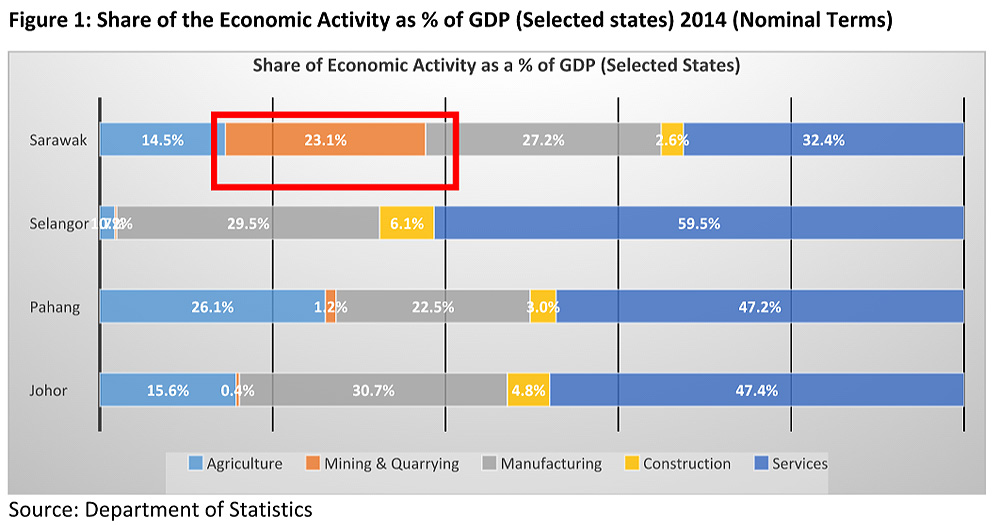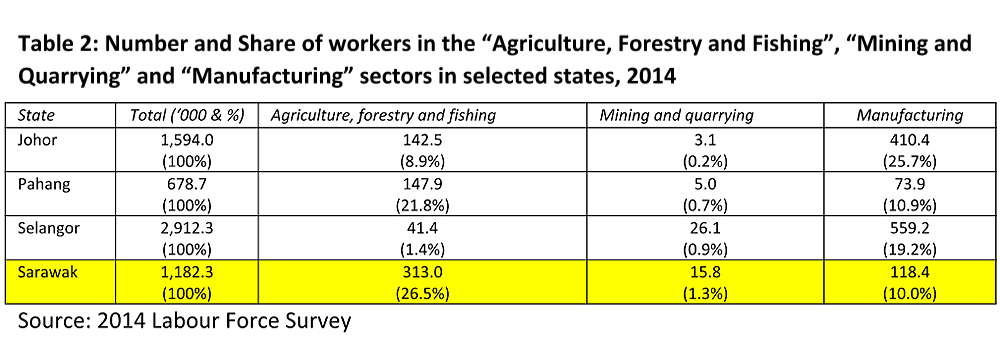COMMENT What if I were to tell you that there is a state in Malaysia where less than two percent of its workforce is responsible for almost one quarter of its economic output? What if I were to also tell you that approximately one quarter of this state’s workforce can only produce less than 15 percent of its economic output?
Naturally, you would come to the conclusion that the economic structure of this state was highly unequal. Welcome to Sarawak, where oil was first discovered in 1910, on Canada Hill in Miri!
Given the importance of the oil and gas in Sarawak, it is not surprising that this sector comprises a significant proportion of the Sarawak economy. According to 2014 statistics, the mining and quarrying sector comprises 23.1 percent of Sarawak’s economy, compared with 0.2 percent for Selangor, 1.2 percent for Pahang and 0.4 percent for Johor.
By comparison, even though a much larger share of the Sarawak workforce is involved in agriculture, this sector only comprises 14.5 percent of Sarawak’s economy ( Figure 1 and Table 1 below )

 However, the mining and quarrying sector employs a mere 15,800 workers or 1.3 percent of Sarawak’s total workforce of 1.18 million in 2014. By comparison, 313,000 workers or 26.5 percent of Sarawak’s workforce is in the “Agriculture, Forestry and Fishing” sectors. (See Table 2 below).
However, the mining and quarrying sector employs a mere 15,800 workers or 1.3 percent of Sarawak’s total workforce of 1.18 million in 2014. By comparison, 313,000 workers or 26.5 percent of Sarawak’s workforce is in the “Agriculture, Forestry and Fishing” sectors. (See Table 2 below).
The large number and percentage of workers who are in the agriculture sector is not that surprising, given that 46 percent of Sarawak is considered rural and 44 percent of the workforce works in the rural areas.

The quarrying and manufacturing sectors
What this means is that 23.1 percent of Sarawak’s output is shared by 1.3 percent of the workforce in the mining and quarrying sector (mostly oil and gas) while 14.5 percent of Sarawak’s output from the agriculture sector is shared by 26.5 percent of the workforce.
Expressed in terms of GDP per worker, each worker in the mining and quarrying sector in Sarawak produces RM1.74 million of the state’s economic output per year, compared to RM55,100 for each worker in the agricultural sector. In other words, a worker in the mining and quarrying sector produces 32 times the output of a worker in the agricultural sector.
Of course, not all of this output goes into the pockets of individual workers. Much of it goes to the companies that produce the oil and gas in Sarawak, such as Shell, and also to the palm oil and logging companies in the agriculture and forestry sectors. But given the much higher output per worker in the oil and gas sector, it is not surprising that wages in this sector are many times that in the agriculture sector.
Similar inequalities can be seen in the manufacturing sector in Sarawak as well. Table 3 below shows the share of manufacturing expressed as a percentage of the state’s GDP (A) and the percentage of that state’s workforce which is in the manufacturing sector (B). The difference between (A) and (B) is shown in the last column of the table.

It is not surprising that a state’s workforce in the manufacturing sector would produce more than its share in terms of economic output, given that the manufacturing sector is usually more productive and uses more capital (i.e. machines), compared with the agriculture and services sector (mostly human labour).
But this difference is the largest for Sarawak among the four states shown above. Ten percent of the workforce in manufacturing produces 27 percent of the output in Sarawak, compared with 19.2 percent of the manufacturing workforce producing 29.5 percent of the output in Selangor.
How can we account for this difference? As a result of the Sarawak Corridor of Renewable Energy (Score) and manufacturing industries related to the oil and gas sector, many of the large manufacturing activities in Sarawak are concentrated in energy-intensive industries such as aluminium smelting, steel plants and petroleum refineries.
According a 2008-09 survey of manufacturing industries, 68 percent of the manufacturing sector in Sarawak comprises “coke and refined petroleum products”. Hence, a relatively small number of workers concentrated in a small number of establishments are able to produce a disproportionate share of the economic output.
Yesterday: Sarawak, a tale of two nations
Tomorrow: Part III on Sarawak, a tale of two nations
DR ONG KIAN MING is the DAP Member of Parliament for Serdang. He can be reached at [email protected]

